 Capezzuoli_Francati
Lun, 23/03/2015 - 22:21
Capezzuoli_Francati
Lun, 23/03/2015 - 22:21
>Avviamo il programma Vasari>
>Impostiamo come unità di misura i metri tramite il comando "Project Units">

>Procediamo con la localizzazione dell'area attraverso il comando "Set Location" , una volta impostato l'indirizzo ci verrà chiesto di localizzare l'area attraverso le mappe di Google.

Cliccando su "Import" ci si apre l'immagine delle mappe di google su Vasari>
>Per la realizzazione dei volumi procediamo utilizzando il comando "Create Mass"; iniziamo ricalcando in pianta con il comando "Line" i vari contorni del nostro palazzo e di quelli limitrofi creando delle superfici; una volta ricalcati tutti i palazzi per estrudere le superfici le selezioniamo ed usiamo il comando "Create Form".

Una volta estruso il solido possiamo gestire la sua altezza cliccando sulle quote che mi compaiono cliccando sulla freccia blu che va verso l'alto. per concludere clicco su "Finish Mass">

Una volta creati i palazzi possiamo procedere calcolando le ombre: cliccando sul simbolo del sole in basso possiamo vedere come il nostro palazzo reagisce alla luce del sole nelle fasce ore e nei differenti giorni dell'anno.
 abbiamo preso per esempio 3 fasce orarie del giorno 20/03/2015 (11.40, 14.15, 16.00)
abbiamo preso per esempio 3 fasce orarie del giorno 20/03/2015 (11.40, 14.15, 16.00)
l'edificio esposto al sole alle ore 11.40:

l'edificio esposto al sole alle ore 14.15:
l'edificio esposto al sole alle ore 16.00:
Abbiamo inoltre fatto un esperimento per vedere come cambiano le ombre nelle diverse stagioni, prendendo per esempio 4 date (21 marzo, 21 giugno, 21 settembre, 21 dicembre), e 4 ore del giorno (9:00, 11:00, 14:00, 17:00).
21 marzo ore 9:00:

21 marzo ore 11.00:

21 marzo ore 14.00:

21 marzo ore 17.00:

21 giugno ore 9:00

21 giugno ore 11.00:

21 giugno ore 14.00:

21 giugno ore 17.00:

21 settembre ore 9.00:

21 settembre ore 11.00:

21 settembre ore 14.00:

21 settembre ore 17.00:

21 dicembre ore 9.00:

21 dicembre ore 11.00:

21 dicembre ore 14.00:

21 dicembre ore 17.00:

Carlotta Capezzuoli, Cecilia Francati
Lun, 23/03/2015 - 23:45 Massa_Marino
Lun, 23/03/2015 - 23:01
Massa_Marino
Lun, 23/03/2015 - 23:01
ANALISI DEL LUOGO
L’area che abbiamo scelto è situata nel quartiere di Centocelle a Roma. Gli edifici studiati sono di forma regolare. Le palazzine in questione hanno tutte un fronte commerciale ed un numero di piani che varia da 2 a 6. L’ abitazione in cui risiede uno degli studenti si trova all’ ultimo piano ed affaccia su una palazzina più bassa. Questo contribuisce ad avere una buona illuminazione solare durante le ore del giorno, in quanto non è soggetta all'ombra portata dalla palazzina adiacente. La facciata principale dell’appartamento è esposta a Nord-Est, mentre la restante parte affaccia a Nord-Ovest. Durante la giornata si ha tendenzialmente una buona illuminazione anche se le stanze che affacciano a Nord risultano fredde in inverno.
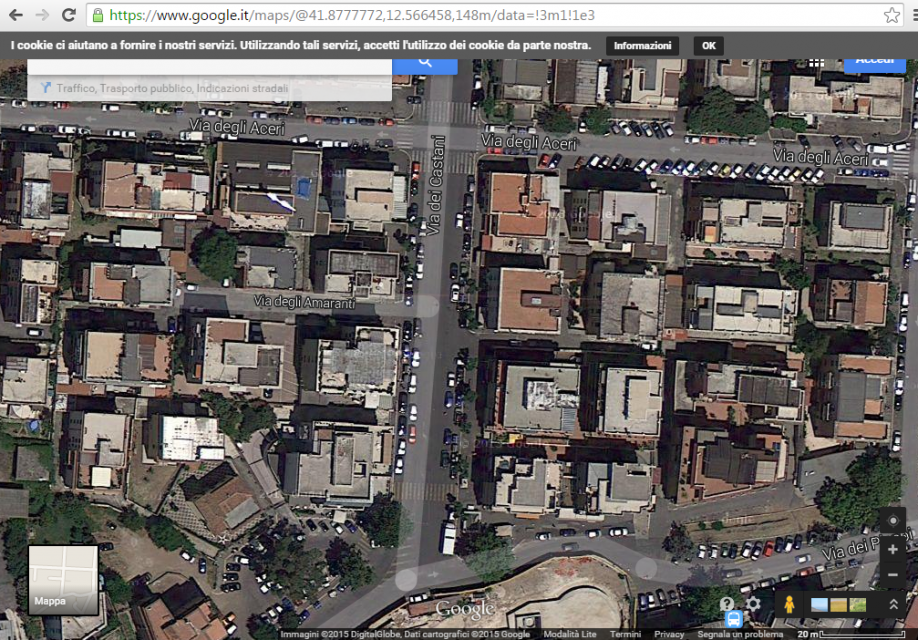
TUTORIAL PROCEDIMENTO MODELLAZIONE
I PASSAGGIO
- Avviare Vasari
- Creare un nuovo documento cliccando su “NEW METRIC” nella lista “PROJECTS” in alto a sinistra.
New Metric

II PASSAGGIO
- Cliccare su “MANAGE” e successivamente su “PROJECT UNITS” (nel sottogruppo “SETTINGS”)
- Da qui inserire la nuova unità di misura “METERS AND CENTIMETERS”
- Si consiglia di utilizzare la visualizzazione “3D VIEW:3D” scegliendola nel menù “PROJECT BROWSER” che si trova sulla sinistra della schermata.
Manage > Project Units > Format > Meters and Centimeters

III PASSAGGIO
- Impostare l’area di riferimento cliccando su “ANALYZE” e successivamente su “LOCATION”
- Inserire l’indirizzo dell’edificio in esame nell’apposita finestra che si andrà ad aprire
- Cliccare su “IMPORT SITE IMAGE”
- Cliccare su “IMPORT” per trasferire la foto sul piano di lavoro
Analyze > Location > Import site image > Import



IV PASSAGGIO
- Cliccare su “MODEL”
- Premere il pulsante “CREATE MASS”
- Lucidare la pianta dell’edificio dopo aver selezionato il comando “LINE” (si consiglia di mettere la visuale “TOP” per lucidare più facilmente)
- Cliccare su “CREATE FORM” e successivamente su “SOLID FORM” per creare il volume dell’edificio
- Per modificare l’altezza dell’edificio cliccare sull’asse Z
- Quando il modello sarà completato cliccare su “FINISH MASS”
- Ripetere l’operazione per ogni edificio che si desidera realizzare
Model > Create Mass > Line > Create Form > Solid Form > Finish Mass

V PASSAGGIO
- Dopo aver alzato gli edifici bisogna cliccare su “SUN PATH ON” per attivare il sole (nella barra in basso)
- Cliccare su “SHADOWS ON” per attivare le ombre (nella barra in basso)
Sun Path On > Shadows On

VI PASSAGGIO
- Evidenziare la barra del sole, cliccare con il tasto destro e successivamente cliccare su “SUN SETTINGS” per impostare data e ora
Sun Settings

VII PASSAGGIO
- Cliccare su “MANAGE” e poi su “CAMERA” per posizionare l’icona sul punto di vista che si preferisce
Manage > Camera

VIII PASSAGGIO
- Per ottenere un immagine renderizzata cliccare “VISUAL STYLE” e successivamente “RAY TRACE”
Visual Style > Ray Trace
ANALISI DELL’EDIFICIO
Per meglio studiare l’effetto della luce del sole nelle diverse fasce orarie abbiamo analizzato l’edificio alle ore 10.00-12.00-14.00-16.15.
Si osserva come nonostante il periodo dell’anno la facciata dell’edificio in esame sia soggetta ad un buon soleggiamento.
Ore 10:00


Ore 12:00


Ore 14:00



Ore 16:15
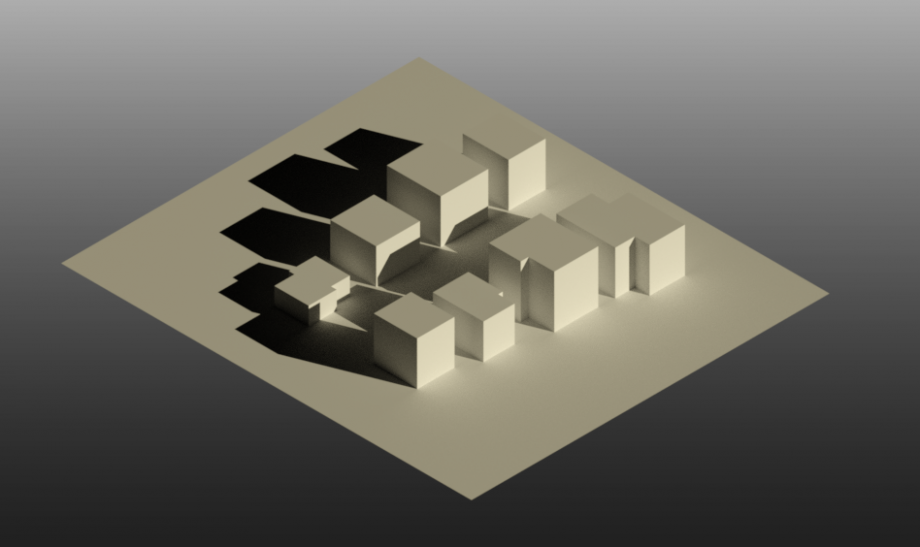


Vista dal balcone dell'edificio preso in esame
ore 10.00
ore 12.00
ore 14.00
ore 16.15

Studenti: Marino Davide, Massa Pierfrancesco
Lun, 23/03/2015 - 23:42
 Faraglia_Gargiulo
Lun, 23/03/2015 - 23:01
Faraglia_Gargiulo
Lun, 23/03/2015 - 23:01
CONTESTO
Nella seguente analisi si è portato avanti, con l'ausilio del programma di modellazione Vasari, lo studio dell'ombreggiamento, considerando in particolare l'edificio sito in via Gerolamo Cardano 184. Si prende, infatti, in considerazione un’area situata in corrispondenza di Piazza Meucci, collocata nel quartiere Portuense del comune di Roma. L’edificio in analisi è un palazzo che si sviluppa su 7 livelli ed è orientato a sud, con un’estensione che va da sud-est a sud-ovest, per quanto riguarda le facciate su strada. All’interno dell’edificio si articolano 4 appartamenti per livello, per un totale di 28, i quali godono tutti di un’ottima esposizione solare.
Si avvia il programma Vasari.

0. Una volta aperto il programma per creare un foglio di lavoro si clicca su “New Metric”.
1. All’interno del foglio, per impostare il lavoro di modellazione, si seleziona la finestra “Project Browser”, in seguito “Views” per cliccare su “3D View: Vasari 3D”.

2.1 Per configurare le unità di misura da scegliere per la modellazione, si seleziona il menù “Manage” e si clicca su “Project Units”.

2.2 Compare un’interfaccia all’interno della quale si seleziona l’unità di misura, in questo caso “Length-1235”.
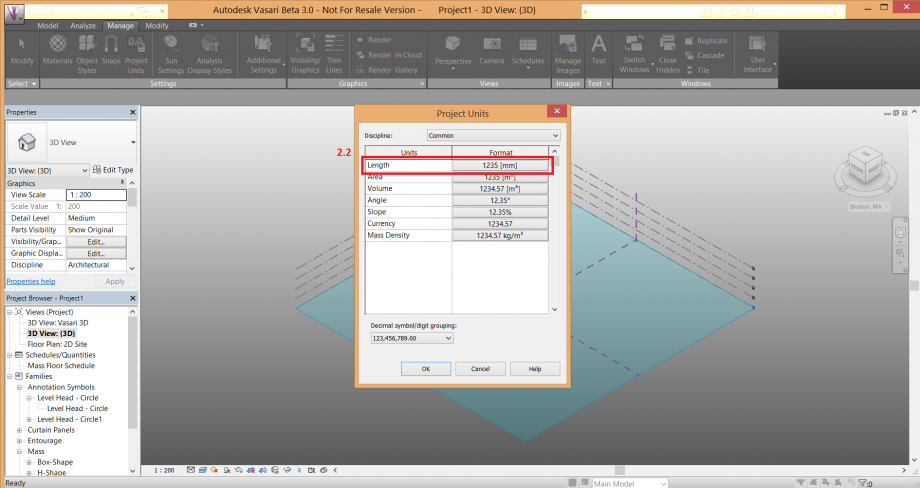
2.3 In seguito sostituiamo l’unità di misura da millimetri in metri.

2.4 Si seleziona su “Rounding” e si clicca su “2 decimal places” per impostare due cifre decimali dopo la virgola. Premere dunque “OK”.
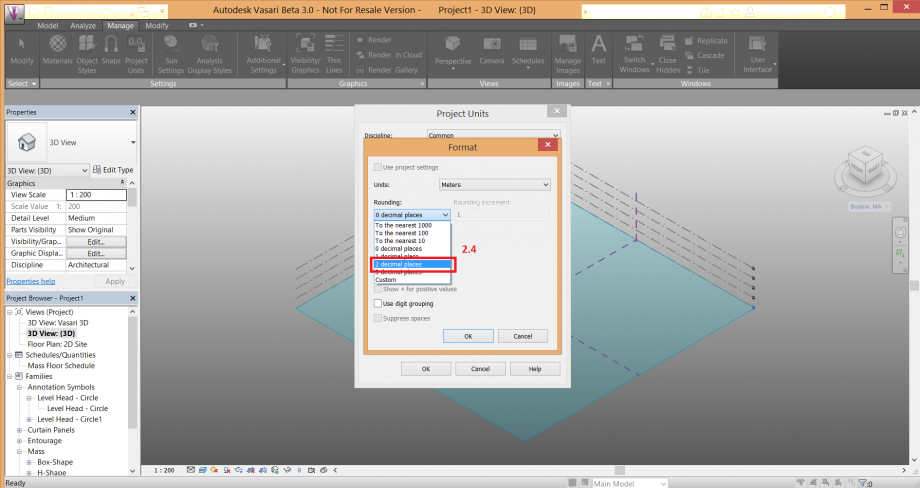
3.1 Definiamo la posizione dell’area attraverso il comando “Location” all’interno del menù “Analyze”.

3.2 Inseriamo, all’interno del “Project Address”, l’indirizzo esatto del palazzo preso in considerazione.

3.3 Clicchiamo poi su “Use Daylight Savings time”.

3.4 Selezioniamo la stazione metereologica 160239 distante 9,01 km dal sito.

3.5 Clicchiamo “Import”.
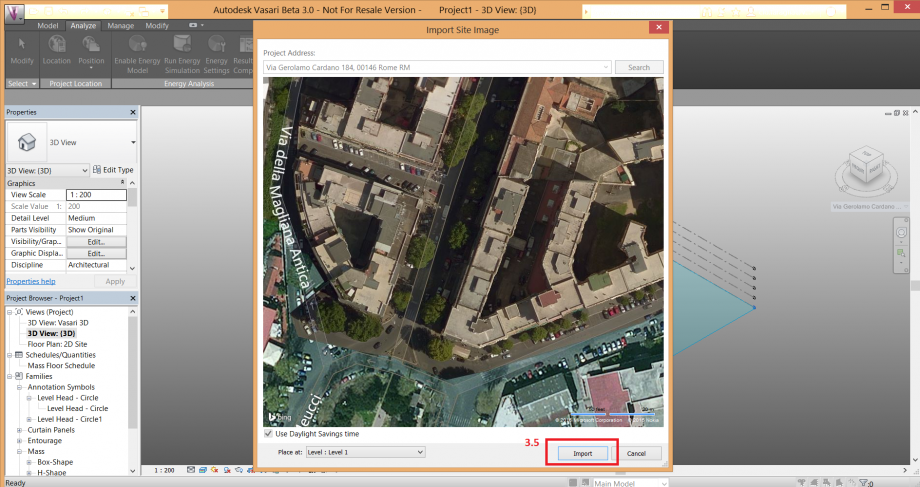
4.1 Per iniziare la modellazione dell’edificio come solido si seleziona sul comando “Create Mass” all’interno del menù “Model”
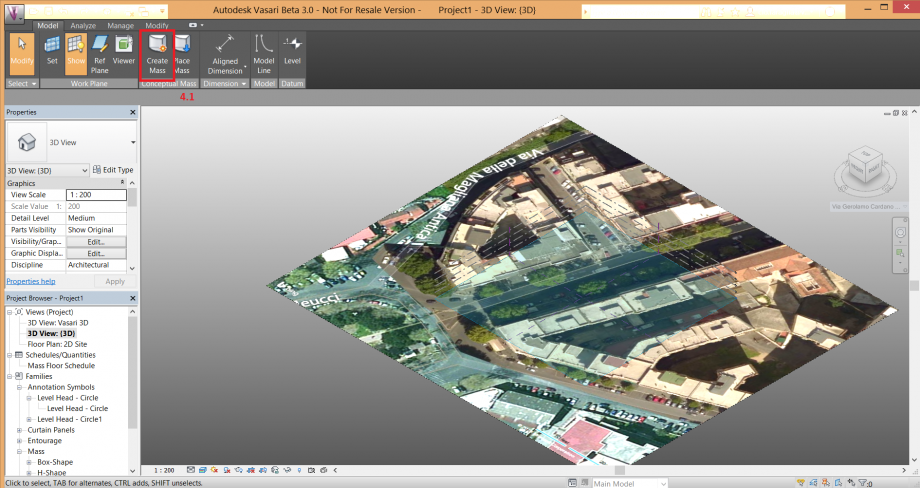
4.2 Utilizzando i comandi “Draw”, all’interno del menù “Modify”, costruiamo i solidi utili all’analisi. Al termine della modellazione si clicca il comando “Finish Mass”.
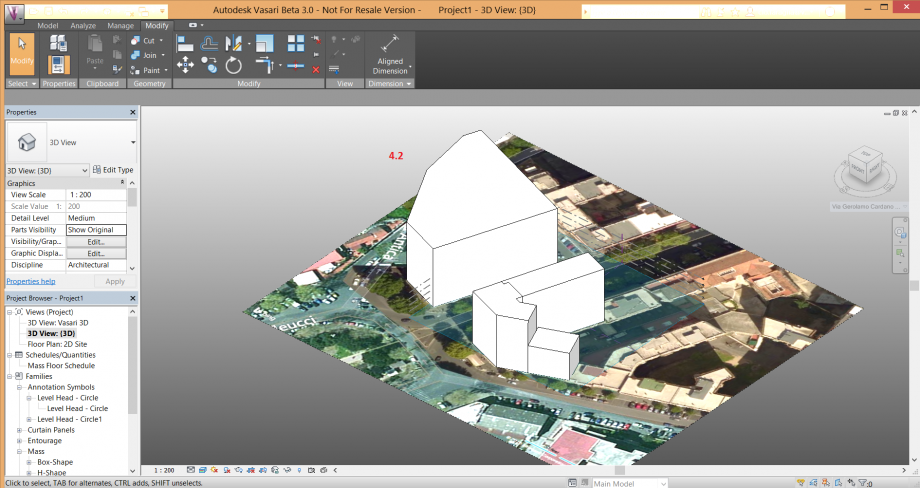
4.3 Iniziamo lo studio del sole e delle ombre e clicchiamo, in basso a sinistra, il comando “Sun Path On” e “Shadows On”.

4.4 e 4.5 Modifichiamo l’ora e la data in base al giorno e alle fasce orarie che si desidera analizzare. Si è dunque scelto di effettuare lo studio nella giornata del 22 marzo 2015 alle ora 10:00, 14:00 e 18:00.
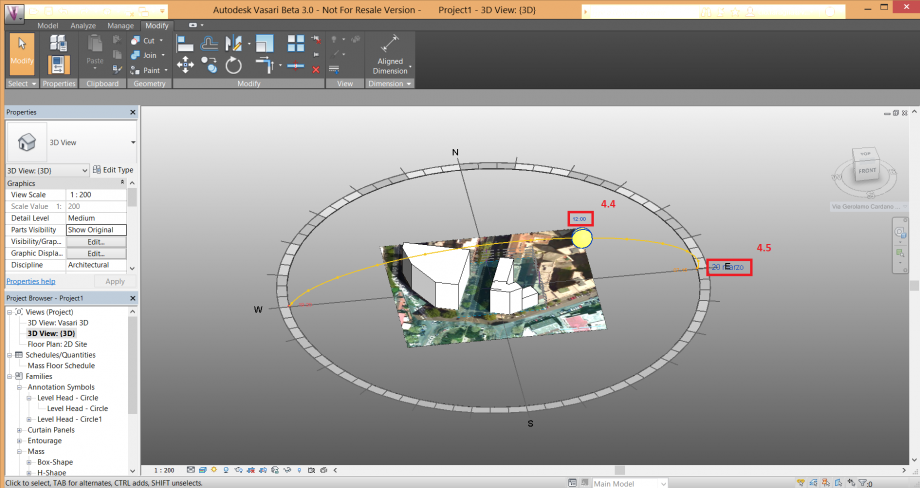
5.1 Ore 10:00


Foto scattata dall'edificio preso in esame, raffigurante l'ombra a terra generata dal palazzo alle ore 10
5.2 Ore 14:00


5.3 Ore 18:00
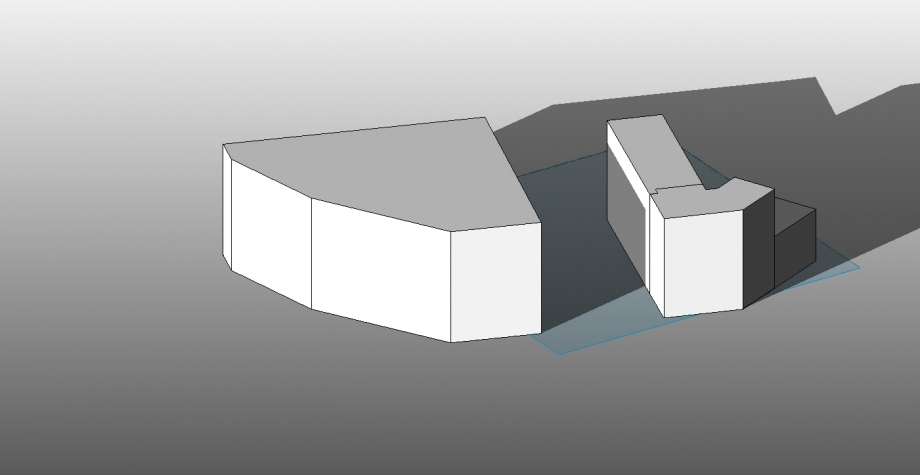

CONCLUSIONI
A seguito dello studio effettuato attraverso il programma, abbiamo potuto confermare le considerazioni iniziali: l’esposizione risulta ideale poiché l’edificio è esposto alla luce solare più preziosa, dal mattino al tramonto. Soltanto gli appartamenti rivolti a sud-est riceveranno la luce al mattino, mentre quelli rivolti a sud-ovest accoglieranno la luce del pomeriggio. Lo specifico appartamento preso in analisi rappresenta però un'eccezione, dal momento che è il risultato dell'unione di due cellule abitative adiacenti; in questo modo l'immobile sfrutta totalmente l'ottimale esposizione dell'edificio, essendo irraggiato durante l'intero arco della giornata. L’edificio risulta parzialmente ombreggiato dalla palazzina sita sul fronte opposto della strada (Via Oderisi da Gubio) soltanto nelle ultime ore del giorno; essa è infatti posta ad ovest rispetto all’edificio preso in esame.
Lo studio è stato poi confrontato con la realtà e qui riportato attraverso foto che rappresentano le zone in ombra e in luce dell’edificio durante le ore del giorno.
Lun, 23/03/2015 - 23:29
 Esposito_France...
Lun, 23/03/2015 - 22:40
Esposito_France...
Lun, 23/03/2015 - 22:40
Introduzione
L'area che abbiamo analizzato si trova nel quartiere di TESTACCIO in una zona prevalentemente adibita a residenze, composta da edifici in linea e palazzine con corte interna . Gli isolati presi in esame sono delle palazzine in linea che si chiudono a formare delle “C” con una corte interna aperta. L’analisi di studio è quella di verificare il comportamento dell'isolato durante le fasi giornaliere prendendo come riferimento il giorno 20 marzo dell'anno 2015 e facendo un confronto con le fotoriproduzioni, attraverso una analisi delle ombre.
L’analisi dell’ombreggiamento degli edifici è stata effettuata confrontando le foto e la riproduzione in Vasari, della facciata esterna rivolta a Sud-Est,alle ore 11:30 del medesimo giorno.

Confronto tra l'immagine reale e quella creata su Vasari


Conclusione
L’isolato analizzato presenta le quattro facciate inclinate di circa 45° rispetto ai punti cardinali, l'edificio é orientato in direzione nord/ovest – sud/est.
Questo comporta, che le facce rivolte a Sud-Est (A) ricevono il sole dall’alba fino a metà mattinata, mentre le facce rivolte a Sud-Ovest (B) sono soleggiate da metà mattinata al tramonto.
E’ da rilevare inoltre che le facce rivolte a Sud-Est (A)ricevono una discreta luce la mattina in primavera, estate e autunno anche se vengono parzialmente oscurate dai palazzi adiacenti, mentre le facce rivolte a sud-ovest ricevono una buona luce grazie all' assenza di edifici adiacenti.
Le facciate rivolte a Nord-Est (C) ricevono soleggiamento solo da aprile fino a settembre nelle ore mattutine dall’alba fino a mezzogiorno, ma sono parzialmente oscurate dai palazzi adiacenti. Infine le facciate esposte a Nord-Ovest (D-E) sono prevalentemente in ombra, da marzo fino a dicembre ricevono il soleggiamento nel pomeriggio. Stessi discorso può farsi per le facciate interne rivolte verso la corte, in questo caso però oltre al soleggiamento e ombreggiamento c’è il parziale oscuramento dell’edificio limitrofo.
Lun, 23/03/2015 - 23:19


